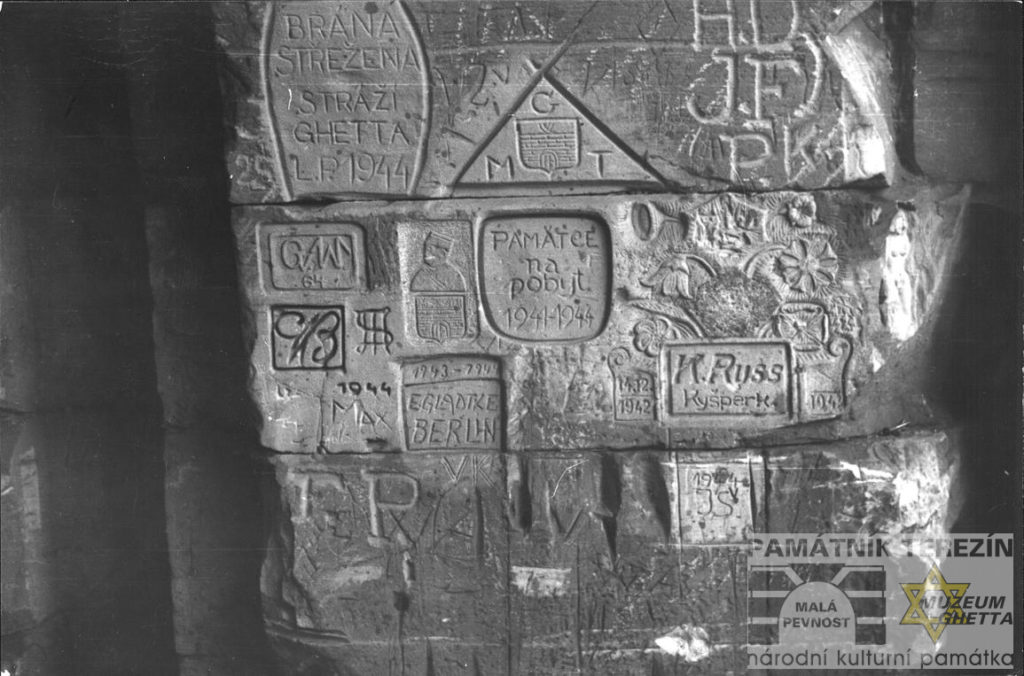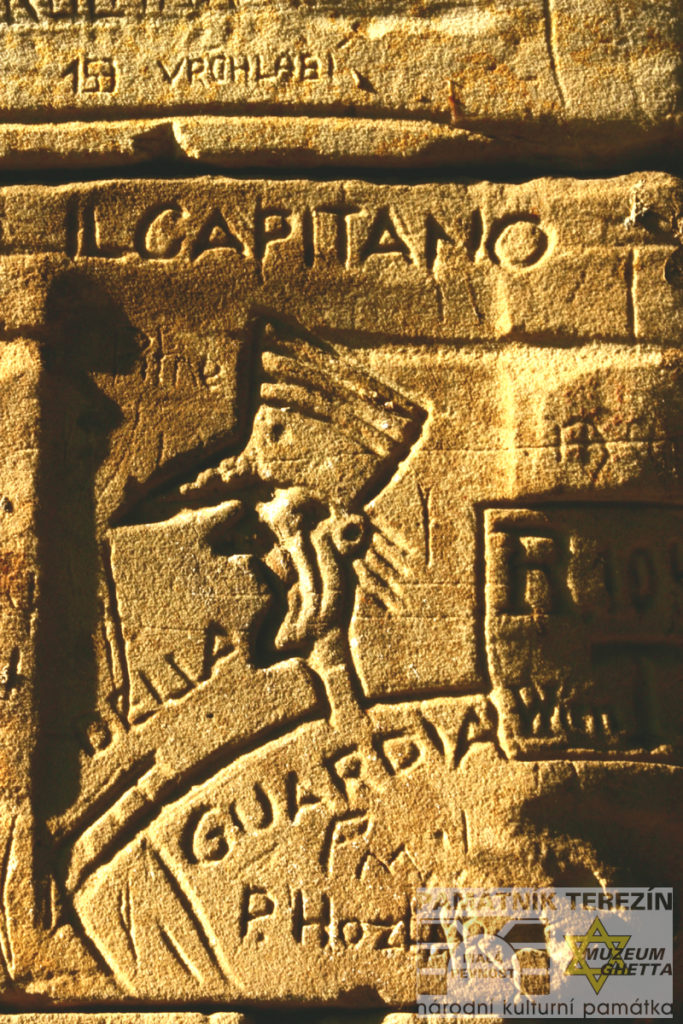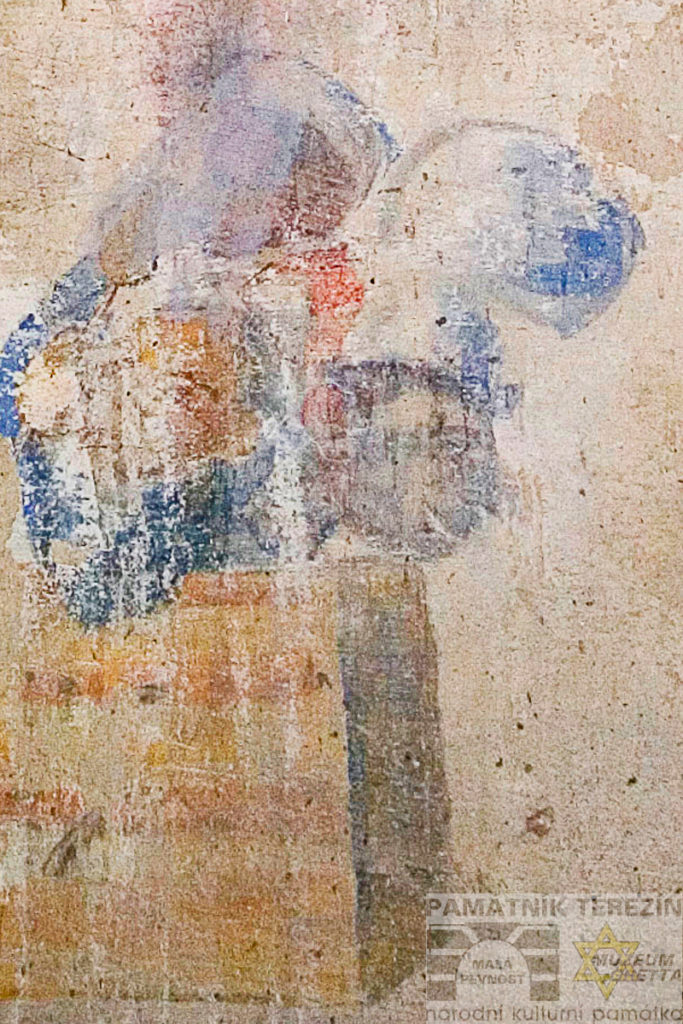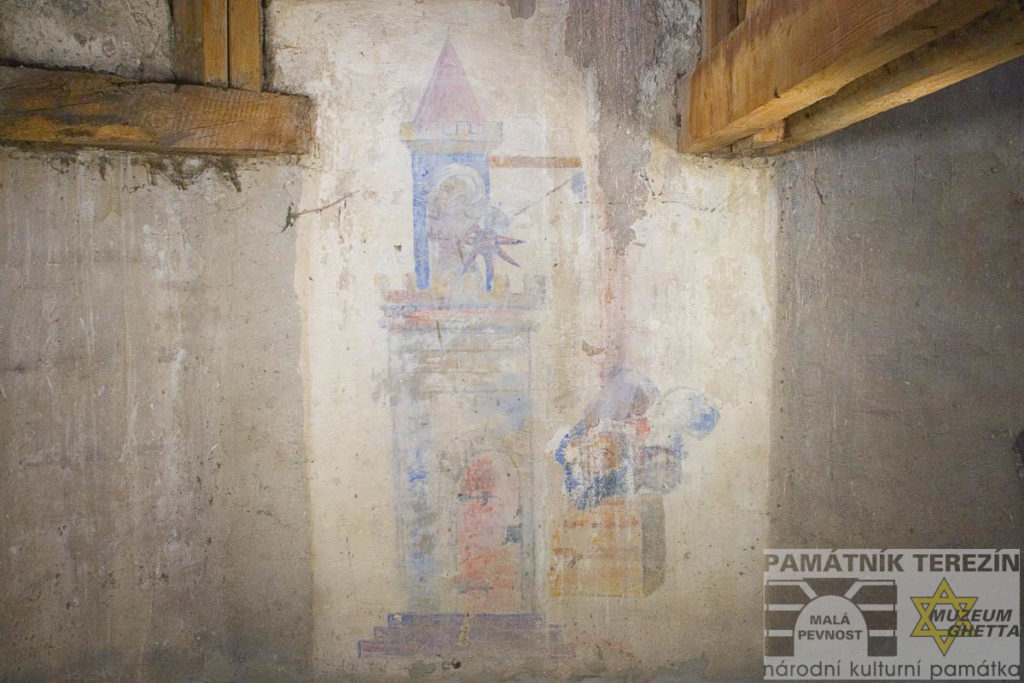Documentation on the Extant Traces from the Time of the Ghetto in the Topography of Today´s Terezín
To date, the history of the Terezín Ghetto (1941 – 1945) has been examined and traced in many extensive studies, and yet the general public is still quite unaware of the fact that the entire town of Terezín hides a great amount of different traces and material relics of that sad period. Many pieces of evidence are hidden out of sight – in attics, cellars and fortifications, and it is not clear for how long these relics will stay intact.
Nowadays, more than 70 years after the war, various structural modifications or traces left behind by the everyday life in the former Ghetto have been preserved in the town´s buildings and open spaces. For instance, there, was a piece of a stage decoration, hand-made shelves or remnants of primitive electrical wiring among the recently found objects. Frequent inscriptions and carvings (graffiti) may also be found on the walls. For instance: “O wants, o wants, o wants je/o akelig beest, wat dans je/dem heelen nacht over my been […]”; in English: “Oh, bedbug, oh bedbug, oh bedbug, you ugly beast dancing on my leg all night long […]”. This is a sarcastic complaint of a Dutch Ghetto inmate suffering from this particular insect in his dwelling. Another inmate depicted the cause of his suffering, bedbugs themselves, directly on the wall.

Quite a unique discovery came when wall paintings were found in a small room in the tower of today´s post-office building. These include scenes from the medieval myths, based on the motives of German songs from the Great Heidelberg Book of Songs (Heidelberger Liederhandschrift, also known as Codex Manesse). However, the individual scenes are greatly distorted. For instance, two drawings feature caricatures in the style of anti-Jewish inflammatory pictures designed to defame the Jews as an inferior race. The reason for their presence in the former Jewish Ghetto lies in the fact that, starting in the fall of 1944, this building came under the direct administration of the SS and, therefore, witnessed large-scale renovations. This brings us to the conclusion that the pictures had been designed and made expressly for SS officers.
A German-Czech team of experts has been working since 2014 on a project aimed at mapping out and documenting all material relics in Terezín. The outcome of its work is presented in on-line documentation at the address: ghettospuren.de. These web pages in three languages are periodically updated.

Selected sites in today´s Terezín are subjected to scientific research and restoration as part of study projects, carried out under the guidance of experts from the Dresden Academy of Fine Arts and the Pardubice University. The results of their research have provided valuable assistance in preserving those precious traces and relics in a long-time horizon.
The Last Messages from the Terezín Ghetto – Mystery of Poterne III
When Poterne III, one of the fortress gates in Terezín, was opened to the public in 2005, it divulged its unique and surprising mystery. It turned out that in this particular passageway, which lay at the borderline of the wartime Ghetto and which was completely out of bounds and forgotten for several decades after the war, its sandstone walls are embossed with countless graffiti, carved inscriptions. There are names, initials, monograms as well as distinctly carved drawings. One can also see there, for instance, a Hanukkah menorah or caricatures of persons dressed in uniforms. And there are also very conspicuous dates 1942, 1943 and 1944. All this has helped in filling some gaps in the history of the Ghetto and its everyday life.

Poterne III – inner wall of the portal (southern wall) in 1945. Photographed after the war by Jiří Lauscher. The picture shows a remembrance site, created by members of the Ghetto Guard, 1945, Terezín Memorial, A 1896. 
Three stripes on the cap and inscription “ IL CAPITANO DELLA GUARDIA” make it clear who was the laughing stock in this case. This striking caricature depicts Artur Weisl, head of the Ghetto Guard during the years 1943/1944, © Archiv Wildfisch, Roland Wildberg, 2005.
“GATE GUARDED BY THE GHETTO GUARD A.D. 1944”. This particular inscription in Poterne III has been the very first piece of concrete evidence to specify the function of the gate during the time of the Ghetto. Members of the Ghetto Guard, known as the Ghettowache, who were recruited from among the male inmates, stood on guard at this gate. Most probably their chief duty was to prevent escapes from the Ghetto and curb smuggling.
Up to this day, urban planner, author, and researcher, Ms. Uta Fischer has deciphered many inscriptions on the walls of Poterne III. A particularly useful tool in deciphering the inscriptions turned out to be the Terezín Memorial´s databank listing the former inmates; this has helped to assign the individual carved inscriptions to specific prisoners. With the help of the database, even mere fragments of such inscriptions make it possible to trace the actual names of the authors and dates on the basis of the available transport data. Until now more than a dozen of such names and life stories have been identified.
Today we know that in most cases those carvings and inscriptions on the walls represented the last messages of their authors before departure from the Ghetto either to other places of persecution or to certain death. Here, in that dark passageway, the inmates jointly created a collective remembrance site, possibly hoping that we will eventually learn of their fate in the future.
The relatives of those people, many of whom now live abroad, had been contacted, came to Terezín to look at the last messages of their ancestors and say goodbye to them by touching their carved inscriptions. These prisoners came from the Protectorate of Bohemia and Moravia, Austria, the Reich and occupied Netherlands.
The results of the research in Poterne III are available to the public on the website ghettospuren.de. Two interactive cards to Poterne III show the most important inscriptions and carved messages, presenting them in a historical context with supplementary information.
The following organizations are involved in the project ”Terezín Ghetto 1941 – 1945. Evidence and Traces“: Terezín Memorial, City of Terezín, Military History Club – Terezín Fortress, Dresden Academy of Fine Arts, Pardubice University, and Büro WILDFISCH Berlin. The project is managed on behalf of the Association of the Friends and Supporters of Terezín, renamed in 2018 to Memento Theresienstadt.
Director of the project: Dipl. – Ing. Uta Fischer.
Ing. Uta Fischer

Representation conforms to what was the routine National Socialist anti-Semitic stereotype of a physically repulsive and lewd Jew, © Archiv Wildfisch, Roland Wildberg, 2016. 
The wall paintings in the tower of Q 617/L 318: the artist was inspired by the miniatures of Herr Kristan von Hamle from the Codex Manesse even though he treated the motif in a considerably different manner, © Archiv Wildfisch, Roland Wildberg, 2015.


